Having more venomous snakes isn’t exactly something to brag about. But at the very least it makes for interesting cocktail party conversation (there’s always plenty of snake-talk at those things). Before we consider whether the Lone Star State or the Magnolia State is number one in venom, let’s consider the state of snakes in the United Snakes — er, the United States.
Venomous Snakes Live Throughout the United States
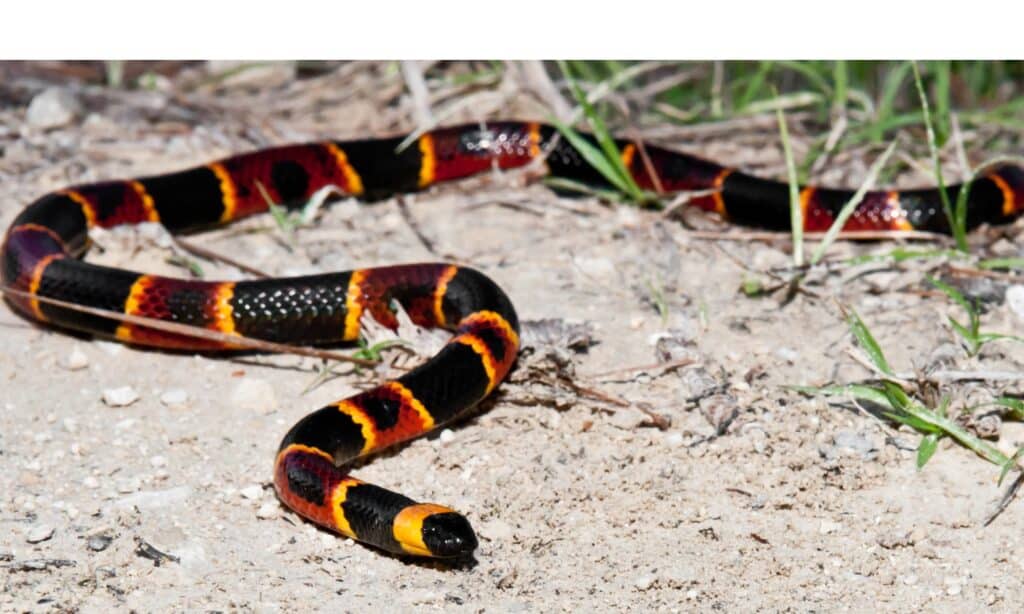
Most U.S. states have at least one native venomous snake species.
©iStock.com/JasonOndreicka
The USA is home to about 50 different species of snakes, and they’re found in the wild in every state but Alaska. Almost all states have at least one venomous species, the exceptions being Alaska, Hawaii, Maine, and Rhode Island. But the southern and southwestern portion of the country is hospitable to a wider variety of species, with diverse habitats that can support different species. It’s hard to get an accurate population count for snakes; they’re very good at hiding. However, one source estimates that Texas has the most of them, with an estimated 800,000 slithery residents. Florida comes in second with a count of 600,000. The next most snake-rich states, Arkansas, Georgia, and Louisiana, are also in the south.
Four Types of Venomous Snakes are Native to the U.S.
Copperhead snakes are masters of camouflage, with colors and patterns that enable them to blend in with a rocky, leafy, or sandy background. Because they’re hard to spot and tend to bite without warning, copperheads bite people more often than almost any other snake species. Fortunately, their venom is relatively weak, though the bite is painful.
Cottonmouth snakes are also known as water moccasins. They spend a lot of time in water, the only venomous snake in the U.S. to do so.
Rattlesnakes famously shake their tails to create a buzzing, rattling warning when they feel threatened. Their rattle is made up of loose segments of skin that knock against each other when the tail vibrates.
Coral snakes can be recognized by their bright bands of black, red, and yellow (which can be pale yellow or white in the southwestern U.S.). Unlike the above three snakes, the coral snake cannot contract its fangs. They have the second-strongest venom of any snake, but it’s difficult for the small-mouthed snake to penetrate human skin. The bite is extremely painful, though, and always a cause to seek medical attention.
Species of all four venomous types are found in both Texas and Mississippi. But which location has the greater number of venomous species? Let’s compare, to determine which state has more venomous snakes.
The State of Texas is Home to 15 Venomous Snake Species

Watch the road: you might spot one of Texas’s ten types of rattlesnakes.
©Janece Flippo/Shutterstock.com
According to the Texas Parks and Wildlife Department, you’ll find 15 species of venomous snakes there (more or less; the exact count depends on which subspecies are counted separately). Rattlesnakes seem particularly fond of the Lone Star state; ten different species of rattlers make their home there. The full roster is: three subspecies of copperheads (Agkistrodon contortrix), one cottonmouth subspecies (Agkistrodon piscivorus leucostoma, the western cottonmouth), one coral snake (Micrurus fulvius tener, the Texas coral snake), and the aforementioned ten rattlesnake species (two are massasauga species, genus Sistrurus; the rest are in the Crotalus genus.) Let’s take a closer look at some of the notable venomous snakes of Texas.
Western Diamondback Rattlesnake (Crotalus atrox)
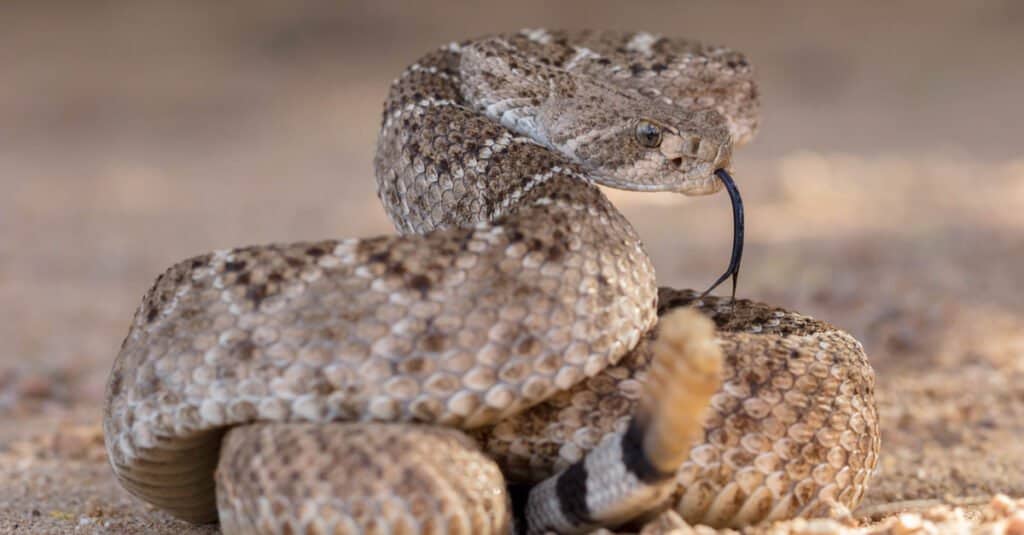
The diamond pattern on the scales identifies the Western Diamondback rattler.
©Alexander Wong/Shutterstock.com
This iconic rattler is the most common, most widespread venomous snake in the state of Texas. The snake is almost cinematic in its appearance, with a thick body, a diamond-shaped pattern running along its back, and dramatic black and white bands above the tail. Speaking of which, that tail can move back and forth 60 times per second or more when the diamondback rattles its rattle.
Western Cottonmouth (Agkistrodon piscivorus leucostoma)
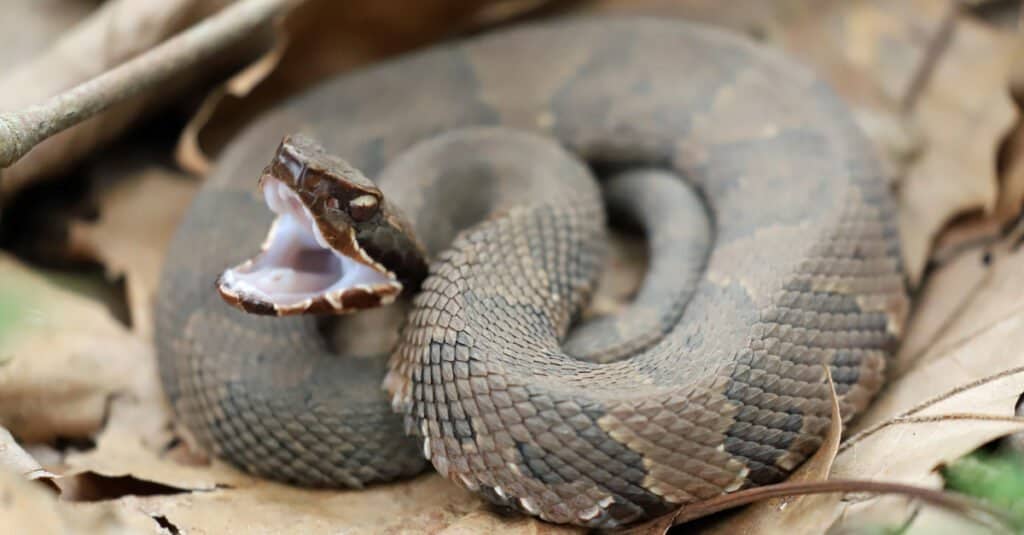
Warning sign: cottonmouths bare their fangs when threatened.
©KF2017/Shutterstock.com
Cottomouths get their name from the white interior of their mouths, which they’ll open wide when they feel threatened. They prefer wet environments like swamps, marshes, and rivers, where they can feed on fish. Cottonmouths also eat other snakes, including each other!
The State of Mississippi is Home to 6 Venomous Snake Species

Mississippi comes up short when it comes to venomous snakes.
©iStock.com/rarrarorro
Which means, sorry Mississippi, Texas has you beat. Or should that be congratulations? Does anybody really want the honor of having an abundance of venomous snakes? In any case, the six venomous snakes in Mississippi are the copperhead (Agkistrodon contortrix), the cottonmouth (Agkistrodon piscivorus), the pygmy rattlesnake (Sistrurus miliarus), the Eastern diamondback rattlesnake (Crotalus adamanteus), the canebrake rattlesnake (Crotalus horridus), and the coral snake (Micrurus fulvius). If those names seem familiar, you’re right. All of them or a similar relative in some cases, are also found in Texas.
Let’s meet some of the venomous snakes of Mississippi.
Canebrake rattlesnake (Crotalus horridus)
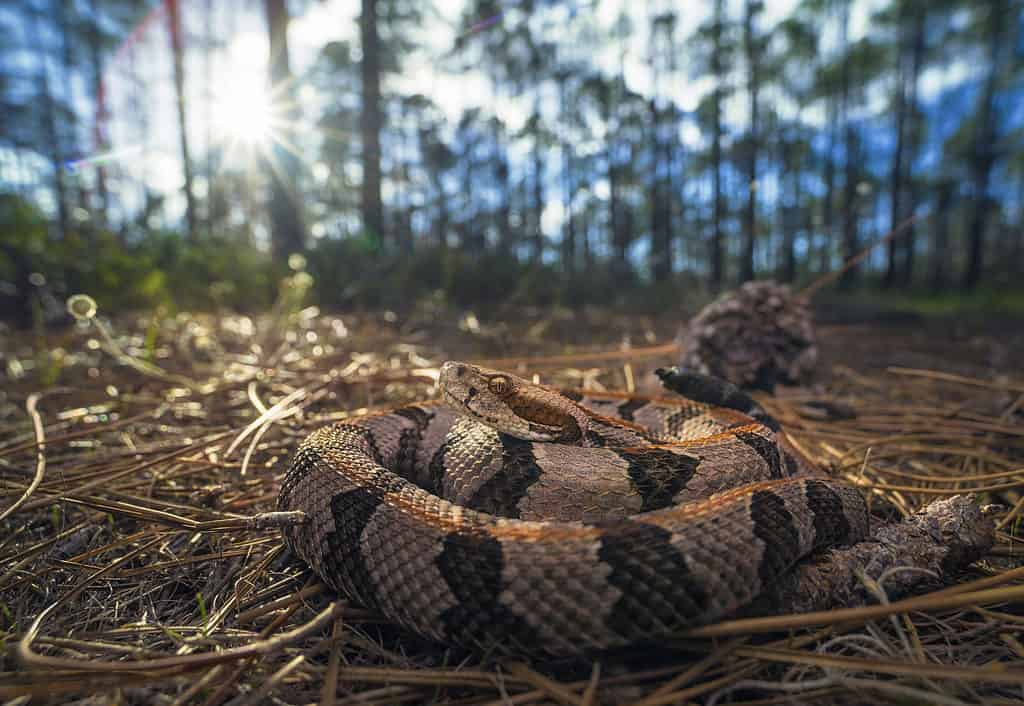
Timber rattlers are widespread eastern snakes.
©Kristian Bell/Shutterstock.com
Also known as the timber rattlesnake, this rattler is widespread in the eastern half of the U.S. They’re found as far north as New York and as far south as Florida. In Mississippi, timber rattlers tend to be found in the forests and river bottoms of the state. They’re not very aggressive, and most bites occur when humans try to approach or handle them, instead of letting the snake alone.
Coral snake (Micrurus fulvius)
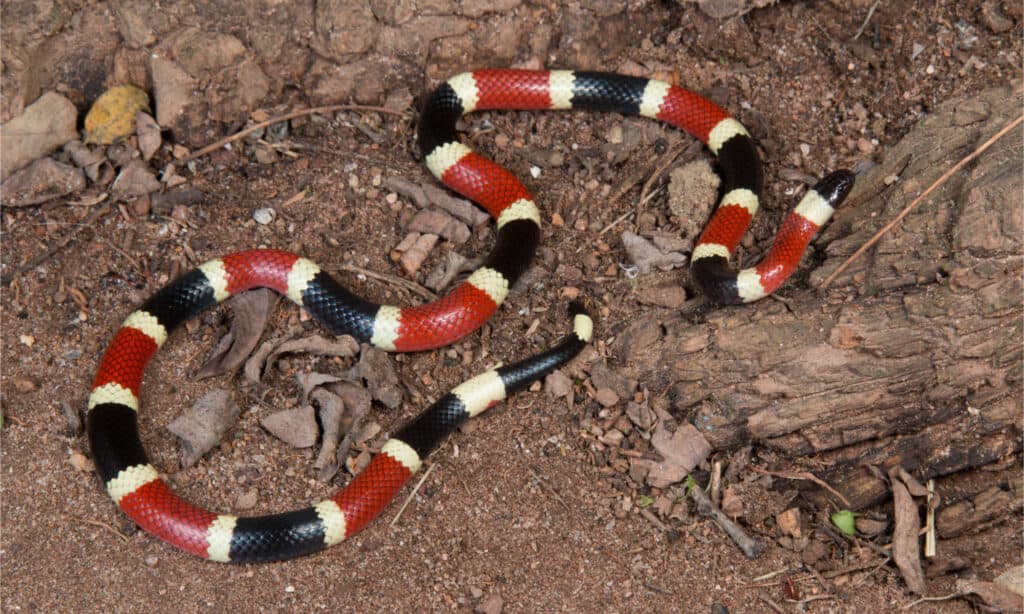
Only coral snakes have red and yellow bands side by side.
©Nathan A Shepard/Shutterstock.com
These snakes are uncommon to rare in Mississippi and tend to hide from people. Some nonvenomous snake species have a red/black/yellow band pattern that resembles the coral snake. But only in coral snakes are the red and yellow bands side by side. To remember that, think of the red and yellow colors of a traffic light being together, or remember the rhyme “red and yellow, kill a fellow.” Better yet, keep your distance from any snake in the wild, and it will likely go its own way.
Venomous Snakes In Texas and Mississippi
| Snake | In Texas | In Mississippi |
| Brown-Banded Copperhead | present | Common Copperhead |
| Cottonmouth | present | present |
| Eastern Copperhead | present | not present |
| Desert Massasauga | present | not present |
| Western Massasauga | present | not present |
| Mojave Rattlesnake | present | not present |
| Prairie Rattlesnake | present | not present |
| Banded Rock Rattlesnake | present | not present |
| Mottled Rock Rattlesnake | present | not present |
| Texas Coral Snake | present | Common Coral Snake |
| Timber Rattlesnake | present | aka Canebreak Rattlesnake |
| Western Diamondback Rattlesnake | present | Eastern Diamondback |
| Western Pygmy Rattlesnake | present | not present |
The photo featured at the top of this post is © iStock.com/johnaudrey
Discover the "Monster" Snake 5X Bigger than an Anaconda
Every day A-Z Animals sends out some of the most incredible facts in the world from our free newsletter. Want to discover the 10 most beautiful snakes in the world, a "snake island" where you're never more than 3 feet from danger, or a "monster" snake 5X larger than an anaconda? Then sign up right now and you'll start receiving our daily newsletter absolutely free.
Thank you for reading! Have some feedback for us? Contact the AZ Animals editorial team.






